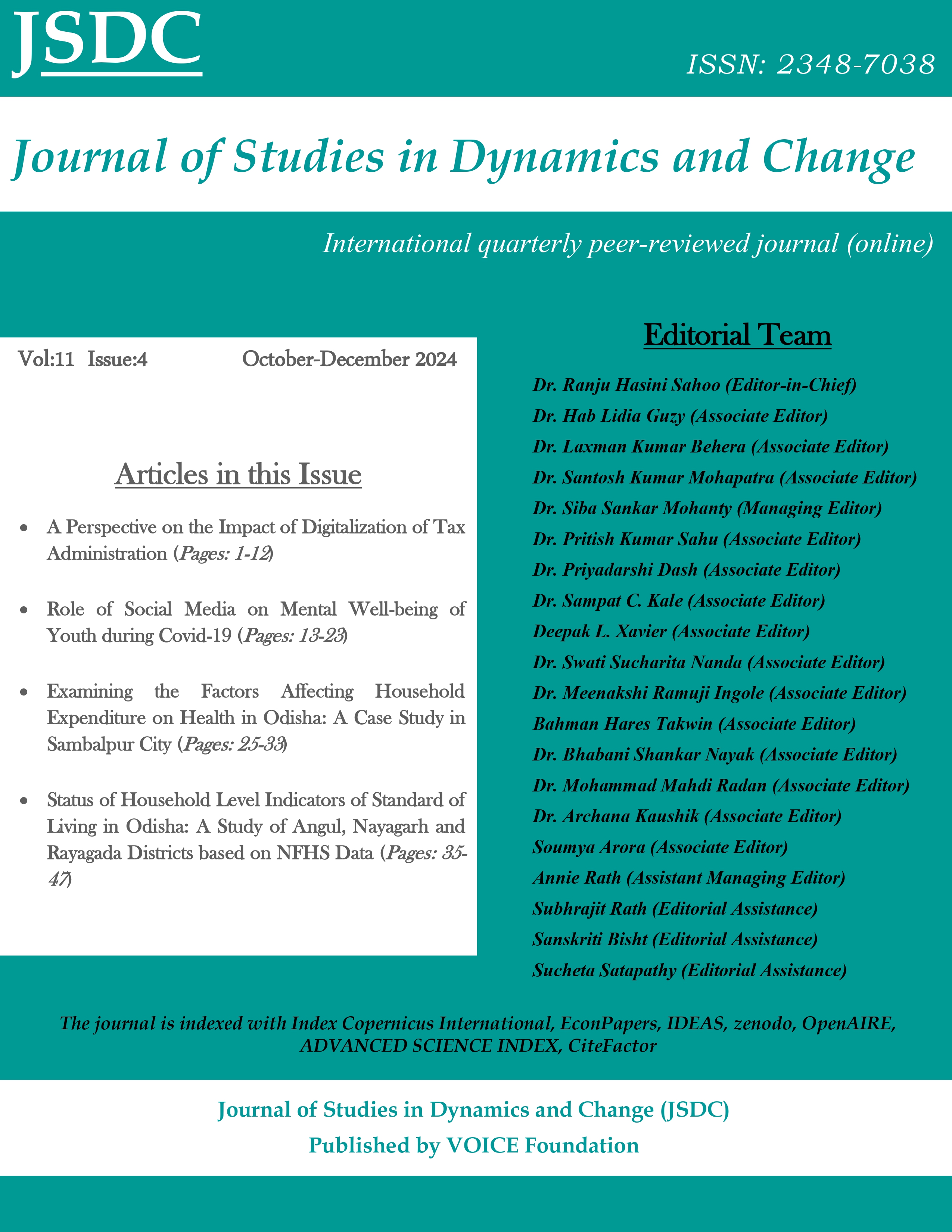Status of Household level indicators of standard of living in Odisha
A study of Angul, Nayagarh and Rayagada Districts based on NFHS Data
Keywords:
Social Indicators development, mobile networking, banking sector, rural & urban growthAbstract
Access to basic amenities such as safe drinking water, toilet facility, electricity, cooking fuel, mobile phone, bank account, health scheme and treatment, own house and pucca house are not only an important measure of socio-economic status of the household, but also fundamental to the health status of the people. So, there are 3 districts, namely, Angul, Nayagarh and Rayagada districts of Odisha taken for analysis of household variables like drinking water, toilet facility, electricity, cooking fuel, mobile phone, bank account, health scheme and treatment, own house and pucca house. The objective of this study to highlight the status and standard of living in households as obtained by by NFHS 4 and 5 survey rounds, and to make a comparison between rural and urban areas of the above mentioned 3 districts and all districts of Odisha. The present study is based on secondary data. The study concludes that in 5 years there have been improvements in all household indicators both in rural and urban areas of the districts of Odisha. Urban development is more than rural development.
References
Tiwari, & Nayak. (2013). DRINKING WATER AND SANITATION. Journal of rural development, Vol. 32, No. (1) , 61 - 74.
• Baranwal, Baranwal, & Roy. (2014). Assocition of Household Environment . frointiers in public health.
• Bora, & Saikia. (2018). Neonatal and under-five mortality rate in. PLOS one.
• Ghosh, & Pal. (2022). "Health and Nutritional Status of Women in. Scholars Journal of Applied Medical Sciences .
• Golder. (2017). Measurement of Domestic Violence . OXFAM India.
• Jhadav, & Tawde. (2022). Wellbeing, occupation, money, education and knowledge: a descriptive study of NFHS-4 data comparing Maharashtra and national data on the wellbeing, occupation, money, education and knowledge parameters. International Journal of Community Medicine and Public Health, 9(6), 2537.
• Kishor, & Gupta. (2004). Women's Empowerment in India and Its States: Evidence from the NFHS. Economic and Political Weekly, 39(7), 694-712.
• kumar, & Paswan. (2021). Changes in socio-economic inequality in nutritional status among. Public Health Nutrition, 24(6), 1304–1317.
• Kumar, & Sahu. (2022). Socio-economic, Demographic and Environmental Factors. Research Gate, 9(2), 23-29.
• Naaz, & Akram. (2017). NutritioNal StatuS of ChildreN aNd adultS iN. Man In India, 97 (23) Part 3 , 655-665.
• Rah, Cronin, Badgaiyan, Aguayo, Coates, & Ahmed. (2014). Household sanitation and personal. BMJ open.
• Rashada, & Sharaf. (2016). Income inequality and intimate partner violence. ECONSTOR.
• Sengupta. (2016). Gender Inequality in Well-being in India: Estimates from NFHS Household-level Data. Economic and Political Weekly, Vol. 51, No. 13, 43-50.
• Sharma , Kumar, Mohanty, & Mozumda. (2022). Comparative analysis of contraceptive. BMC public health, 22:781.
• Sharmaa, Singhb, & Srivastavaa. (2017). Socio-economic inequality and spatial heterogeneity in anaemia among. ELSEVIER.
Downloads
Published
How to Cite
Issue
Section
License
Copyright (c) 2025 Journal of Studies in Dynamics and Change (JSDC)

This work is licensed under a Creative Commons Attribution-NonCommercial-ShareAlike 4.0 International License.
Readers and users of the Journal of Studies in Dynamics and Change (JSDC) are free to Share — copy and redistribute the papers published in the journal in any medium or format. However, the user (1) must give appropriate credit, provide a link to the license, and indicate if changes were made. (2) May not use the material for commercial purposes (3) Must distribute your contributions under the same license as the original if any remix, transform, or build upon the material is done.


